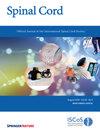星形胶质细胞中的BDNF-GABA信号:通过MSC治疗增强脊髓损伤后的神经修复。
IF 2.2
4区 医学
Q3 CLINICAL NEUROLOGY
引用次数: 0
摘要
研究设计:综合生物信息学数据研究。目的:本研究旨在通过生物信息学分析,绘制星形胶质细胞景观,探索关键信号通路,揭示MSCs和iPSCs促进SCI恢复的分子机制。单位:北京清华长庚医院,清华大学临床医学院。方法:我们对来自Gene Expression Omnibus (GEO)数据集的单细胞转录组(scRNA-seq)、空间转录组和大量RNA-seq数据进行了生物信息学分析。数据处理涉及到像“Seurat”、“DESeq2”和“WGCNA”这样的R包。对于途径富集,我们使用基因集富集分析(GSEA)和富集web服务器。结果:单细胞和空间转录组分析显示,SCI后星形胶质细胞景观发生了显著变化,突出了损伤区域内星形胶质细胞群的显著破坏。研究结果表明,BDNF调节GABA神经传递和GABA受体信号在星形胶质细胞中起着促进神经元再生的关键作用。此外,hUC-MSCs通过激活bdnf调节的星形胶质细胞的GABA信号来增强神经修复。一种有希望的替代方法是ips衍生的MSCs,它已显示出通过星形胶质细胞的BDNF、GABA和GABA受体信号通路促进神经再生的潜力。结论:总之,脊髓损伤破坏星形胶质细胞群,影响其支持神经修复的能力。星形胶质细胞中bdnf调节的GABA信号对于神经元再生至关重要。hUC-MSCs和ips衍生的MSCs都显示出通过激活这些通路来增强神经恢复的希望,为脊髓损伤提供了潜在的新治疗选择。本文章由计算机程序翻译,如有差异,请以英文原文为准。

BDNF-GABA signaling in astrocytes: enhancing neural repair after SCI through MSC therapies
An integrated bioinformatics data study. This study, through bioinformatics analysis, aims to map the landscape of astrocytes, explore key signaling pathways, and uncover molecular mechanisms that support SCI recovery facilitated by MSCs and iPSCs. Beijing Tsinghua Changgung Hospital, School of Clinical Medicine, Tsinghua University. We performed a bioinformatics analysis of single-cell transcriptomes (scRNA-seq), spatial transcriptomics, and bulk RNA-seq data sourced from Gene Expression Omnibus (GEO) datasets. The data processing involved R packages like “Seurat,” “DESeq2,” and “WGCNA.” For pathway enrichment, we used Gene Set Enrichment Analysis (GSEA) and the Enrichr web server. Single-cell and spatial transcriptomic analysis revealed notable changes in the astrocyte landscape after SCI, highlighting a significant disruption in astrocyte populations within the injured region. Findings suggest that BDNF regulation of GABA neurotransmission and GABA receptor signaling in astrocytes plays a key role in promoting neuronal regeneration. Additionally, hUC-MSCs were found to enhance neural repair by activating BDNF-regulated GABA signaling of astrocytes. A promising alternative involves iPS-derived MSCs, which have shown potential to boost neural regeneration through BDNF, GABA, and GABA receptor signaling pathways of astrocytes. In summary, SCI disrupts astrocyte populations, impacting their ability to support neural repair. BDNF-regulated GABA signaling in astrocytes is essential for neuron regeneration. Both hUC-MSCs and iPS-derived MSCs show promise in enhancing neural recovery by activating these pathways, offering potential new therapeutic options for SCI.
求助全文
通过发布文献求助,成功后即可免费获取论文全文。
去求助
来源期刊

Spinal cord
医学-临床神经学
CiteScore
4.50
自引率
9.10%
发文量
142
审稿时长
2 months
期刊介绍:
Spinal Cord is a specialised, international journal that has been publishing spinal cord related manuscripts since 1963. It appears monthly, online and in print, and accepts contributions on spinal cord anatomy, physiology, management of injury and disease, and the quality of life and life circumstances of people with a spinal cord injury. Spinal Cord is multi-disciplinary and publishes contributions across the entire spectrum of research ranging from basic science to applied clinical research. It focuses on high quality original research, systematic reviews and narrative reviews.
Spinal Cord''s sister journal Spinal Cord Series and Cases: Clinical Management in Spinal Cord Disorders publishes high quality case reports, small case series, pilot and retrospective studies perspectives, Pulse survey articles, Point-couterpoint articles, correspondences and book reviews. It specialises in material that addresses all aspects of life for persons with spinal cord injuries or disorders. For more information, please see the aims and scope of Spinal Cord Series and Cases.
 求助内容:
求助内容: 应助结果提醒方式:
应助结果提醒方式:


